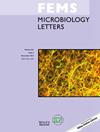Organization, Conservation, and Diversity of Biosynthetic Gene Clusters in Bacillus sp. BH32 and Its Closest Relatives in the Bacillus cereus Group
IF 2.2
4区 生物学
Q3 MICROBIOLOGY
引用次数: 0
Abstract
This study explores the organization, conservation, and diversity of biosynthetic gene clusters (BGCs) among Bacillus sp. strain BH32, a plant-beneficial bacterial endophyte, and its closest non-type Bacillus cereus group strains. BGC profiles were predicted for each of the 17 selected strains using antiSMASH, resulting in the detection of a total of 198 BGCs. We quantitatively compared the BGCs and analyzed their conservation, distribution, and evolutionary relationships. The study identified both conserved and singleton BGCs across the studied Bacillus strains, with minimal variation, and discovered two major BGC synteny blocks composed of homologous BGCs conserved within the B. cereus group. The identified BGC synteny blocks provide insight into the evolutionary relationships and diversity of BGCs within this complex group.蜡样芽孢杆菌 BH32 及其近亲中生物合成基因簇的组织、保存和多样性
本研究探讨了有益于植物的内生细菌芽孢杆菌 BH32 菌株及其最接近的非蜡样芽孢杆菌属菌株之间生物合成基因簇(BGC)的组织、保存和多样性。利用 antiSMASH 对 17 个选定菌株的 BGC 图谱进行了预测,结果共检测到 198 个 BGC。我们对这些 BGC 进行了定量比较,并分析了它们的保守性、分布和进化关系。该研究在所研究的芽孢杆菌菌株中发现了保守的和单一的 BGCs,且差异极小,并发现了由蜡样芽孢杆菌群内保守的同源 BGCs 组成的两个主要 BGC 同源区块。所发现的BGC同源区块有助于深入了解这一复杂菌群中BGC的进化关系和多样性。
本文章由计算机程序翻译,如有差异,请以英文原文为准。
求助全文
约1分钟内获得全文
求助全文
来源期刊

Fems Microbiology Letters
生物-微生物学
CiteScore
4.30
自引率
0.00%
发文量
112
审稿时长
1.9 months
期刊介绍:
FEMS Microbiology Letters gives priority to concise papers that merit rapid publication by virtue of their originality, general interest and contribution to new developments in microbiology. All aspects of microbiology, including virology, are covered.
2019 Impact Factor: 1.987, Journal Citation Reports (Source Clarivate, 2020)
Ranking: 98/135 (Microbiology)
The journal is divided into eight Sections:
Physiology and Biochemistry (including genetics, molecular biology and ‘omic’ studies)
Food Microbiology (from food production and biotechnology to spoilage and food borne pathogens)
Biotechnology and Synthetic Biology
Pathogens and Pathogenicity (including medical, veterinary, plant and insect pathogens – particularly those relating to food security – with the exception of viruses)
Environmental Microbiology (including ecophysiology, ecogenomics and meta-omic studies)
Virology (viruses infecting any organism, including Bacteria and Archaea)
Taxonomy and Systematics (for publication of novel taxa, taxonomic reclassifications and reviews of a taxonomic nature)
Professional Development (including education, training, CPD, research assessment frameworks, research and publication metrics, best-practice, careers and history of microbiology)
If you are unsure which Section is most appropriate for your manuscript, for example in the case of transdisciplinary studies, we recommend that you contact the Editor-In-Chief by email prior to submission. Our scope includes any type of microorganism - all members of the Bacteria and the Archaea and microbial members of the Eukarya (yeasts, filamentous fungi, microbial algae, protozoa, oomycetes, myxomycetes, etc.) as well as all viruses.
 求助内容:
求助内容: 应助结果提醒方式:
应助结果提醒方式:


